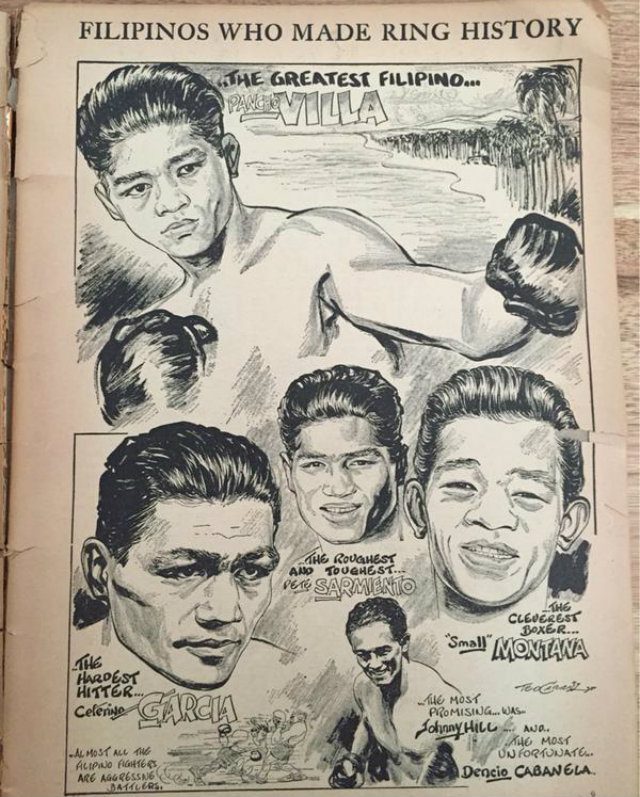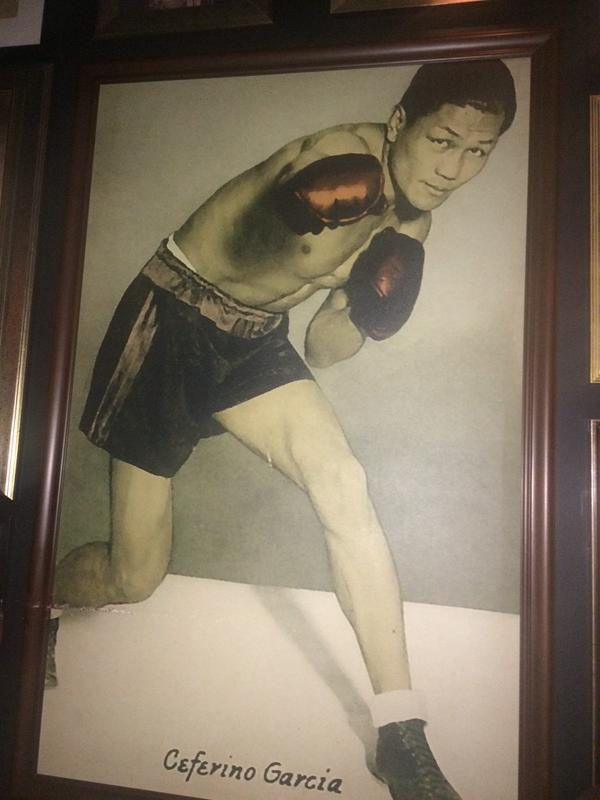SUMMARY
This is AI generated summarization, which may have errors. For context, always refer to the full article.

MANILA, Philippines – Long before Pacquiao, Penalosa, Espinosa and even Elorde, there was a group of Philippine boxing pioneers whose names have faded with time, but whose accomplishments remain forever buried in the sport’s history books.
If Manny Pacquiao, Nonito Donaire Jr and Brian Viloria were the leading lights of a renaissance of Philippine boxing, then Pancho Villa, Pete Sarmiento, Small Montana, Ceferino Garcia, Johnny Hill and Dencio Cabanela were part of the first wave of Pinoy boxers to make an impact on the world stage.
A cartoon from The Ring magazine’s December 1938 issue (sent to me by Daniel Attias of Boxing.com) immortalized their feats, with Villa being declared “The greatest Filipino,” Garcia “the hardest hitter,” Montana “the cleverest boxer;” Sarmiento “the roughest and toughest;” “the most promising” Johnny Hill; and “the most unfortunate” Dencio Cabanela.
Villa, the first Filipino boxer to win a world title, was the second Filipino to be named to the International Boxing Hall of Fame (going in as an ‘Old Timer’ a year after Flash Elorde in 1994). The Iloilo native fought pro for only 6 years but amassed an incredible record of 77-4-4 (22 knockouts) and made his mark on history by knocking out Jimmy Wilde in 1923 to win the flyweight title at the Polo Grounds in New York.
Who knows how long Villa could have reigned: He was only 23 years old when he died in 1925, the result of a tooth infection which spread. Villa also wasn’t shy about giving his countrymen a shot at the belt, decisioning Clever Sencio over 15 rounds at Wallace Field in Manila.
—
Anyone who has walked into Salon de Ning at The Peninsula Manila will have seen the painting of Ceferino Garcia hanging in the boxing mini-room. Garcia, a rare Asian middleweight, earned a reputation as a heavy hitter with 74 knockouts 118 wins (against 30 losses and 14 draws).
Born in Tondo, Garcia won recognition as middleweight champion by the New York State Athletic Commission in 1939 with a knockout over Fred Apostoli in 1939, then fought Henry Armstrong, one of the greatest boxers to ever live, to a draw the following year.
Garcia’s Wikipedia page paints the picture of a tough street guy whose reputation preceded him: a first grade dropout, renowned street fighter/gambler and a “skilled blacksmith.” Garcia went on to have a few brief movie roles and retired in California.

—
Pete Sarmiento never received a world title shot but earned a reputation as “the roughest and toughest”during a 14-year career. Sarmiento, a Penaflorida, Pampanga native whose record stretched to 37-21-14 (15 KOs), battled the likes of Villa and Tony Canzoneri in his career and was even regarded as the best Filipino to that date by at least one boxing spectator.
“You can all pick Villa. But I’ll always insist that Pete Sarmiento was the greatest of them all,” boxing manager Eddie Long was quoted in a 1927 article in the Milwaukee Journal. That same article went on to explain why his career never panned out: “Pete, however, had no love for training and finally had to pay the toll for his folly – he was whipped by smaller opponents.”
—
Small Montana, one of the earliest in a long line of great boxers from Negros Occidental, turned pro in 1930 and invaded the United States two years later. Known for his boxing skill and crafty jab, the boxer born Benjamin Gan won the New York version of the flyweight world championship in 1935 with a decision over Midget Wolgast.
Though he started his career in the Philippines, Montana fought also in England, USA, Mexico and Cuba during his career, amassing a record of 82-22-10 (11 knockouts).
Johnny Hill, born to an African-American sailor and a Filipino mother, Hill was, like Sarmiento, Cabanela and Villa, under the management of Frank Churchill, a US Customs house clerk based in Manila. Hill turned pro in 1922 and made his US debut in 1926. His bio on Boxrec.com tells the sad story of why he never panned out: “Once regarded as one of the beat Filipino fighters that ever invaded US. However, the city lights and lack of proper training told its tale.
“Down and out financially, he had to beg in the streets in his hometown. In the 1950s (he) was a beneficiary of the Philippines Sportswriters Association.”
Dencio Cabanela, known as the Olongapo Kid, didn’t follow the previous boxers to the States. Instead he went to Australia, where he would meet his untimely demise at age 21.
Cabanela, a popular bantamweight boxer who won the Orient featherweight and lightweight titles, was known for his ability to absorb tremendous punishment before rallying back to win. His luck began to change when he traveled to Australia in 1921 to fight Eugene Criqui in March and was knocked out in 14 rounds. It was suspected that he had suffered a blood clot in his brain, yet he was shockingly back in the ring again the following month. Two weeks after, he was knocked out in 17 rounds and less than two months later was knocked out once more. This time, he would not recover.
Cabanela’s unconscionable fight schedule almost certainly contributed to his death. Boxing matchmaker Joe Waterman later told the Tacoma News-Tribune that Cabanela was the “most naturally gifted fighter he ever saw.” – Rappler.com
Add a comment
How does this make you feel?
There are no comments yet. Add your comment to start the conversation.